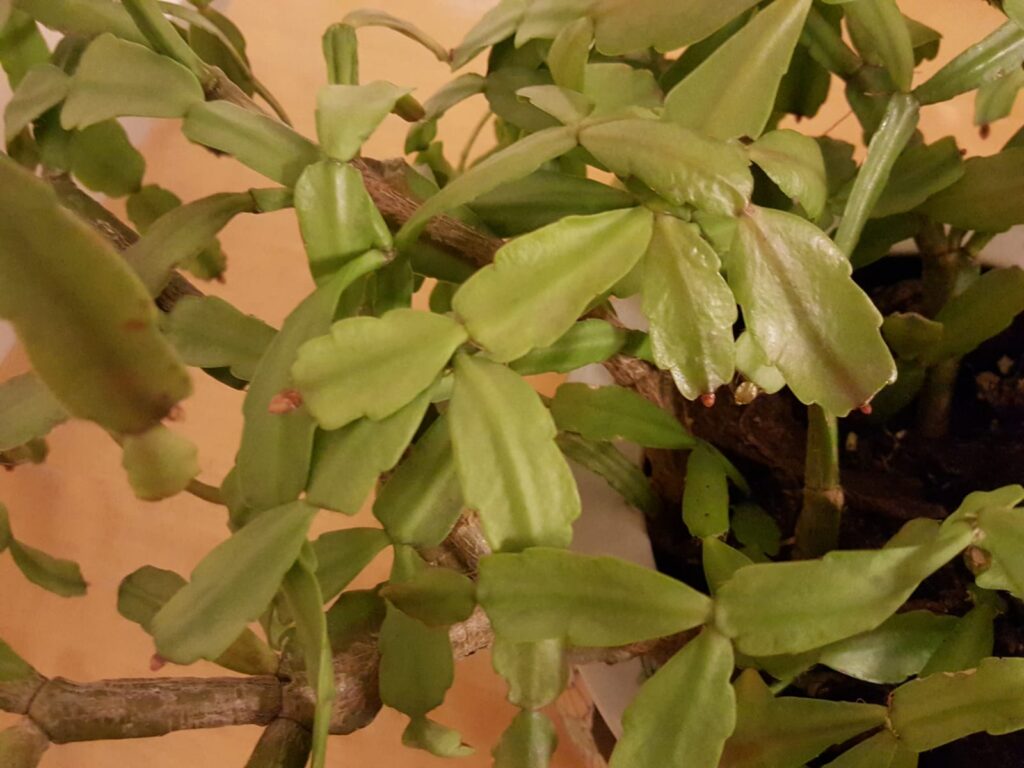
Dear Master Gardener,
I have this christmas cactus (Schlumbergera buckleyi) plant for over a decade. Its mother plant is at least 30 years old. I remember that for the first few years, its leaf segments were plump and luscious-looking bright green but no blooms. Then, I start to give it a summer vacation until the first frost and it has been giving us blooms every year for at least 3 years now. However, it’s leaves are no longer good looking as shown in the photo. The whole plant looks like a weeping willow. I just pruned and repotted the plant this summer – its look still remains the same. How to take care of this plant so that I can have both blooms and green plump leaves – overall, a good-looking and healthy plant?
Many thanks for your guidance and information.
Thank you for contacting Toronto Master Gardeners regarding growing your Christmas cactus (Schlumbergera x buckleyi) to health.
The Christmas cactus (Schlumbergera x buckleyi) is a frost-intolerant hybrid epiphyte developed by W. Buckley, in 1850, from a cross between two species (S. truncate and S. russelliana) native to southern Brazil (MBG). Although your plant is a member of the cactus family, it is an epiphyte which grows on trees or rocks, similar to orchids. Your care over the years has contributed to its health, blooming and longevity. You have transplanted it effectively, however the type of soil used has not been indicated. It is very good to give this plant a summer vacation, but it is not quite clear what you mean by “until the first frost”. From your photo, one can see many buds and leaves that are a bit desiccated but are also pale green in colour. The light colour would suggest a deficit of nutrients and/or excess sun exposure. Perhaps a tweaking of your growing regimen may be of benefit as follows:
- Light – Outdoors, the Christmas cactus is grown in partial shade, i.e. 2-4 hours per day of early morning or late afternoon sun, see: https://www.gardeningknowhow.com/garden-how-to/info/partial-shade.htm That your plant has many buds would indicate that outdoor day length has stimulated the blooming cycle. Indoors, the lighting should be adjusted to simulate the shortening day length of late summer and fall as prolonged indoor light may interfere with the blooming cycle. Avoid excess sun outdoors as this may result in pale, bleached-out leaves.
- Soil: The soil should be a well-drained potting medium containing one part potting soil, two parts peat moss and one part sharp sand or perlite.
- Water: Desiccated leaves would suggest under-watering during the active growth period. Overwatering will result in root damage and rot – avoid too large pots for plant size as the plant prefers to be pot-bound. Being a succulent, the soil should have consistently medium moisture during its growth period from March to September. Water from below once the top one inch is dry. From late winter to spring, reduce watering but do not allow the soil to dry out completely.
- Nutrients: Pale green leaves may result from a lack of nutrients. Fertilize your plant monthly with a general houseplant fertilizer during the growing season, but reduce fertilization during fall and winter. Follow fertilizer directions closely.
- Temperature: The bloom cycle is also stimulated by mid-September nighttime temperatures in the 10-13⁰C range. Although your plant is outside until first frost, the night-time temperatures are not mentioned. It is possible that your plant is suffering from cold stress if the day or night temperatures dip below 10⁰C. Bring indoors once the temperature drops to 10⁰C. These plants also do not do well in temperatures in excess of 32⁰C.
- Prune by twisting off the leaf sections to groom your cactus into a pleasing shape and size.
Bud drop: This succulent may respond to stress by dropping its buds. To minimize bud drop, avoid excess temperatures, large fluctuations in temperature, inconsistent watering, and sudden environmental changes such as moving it to a different location.
For more information, please see: https://www.torontomastergardeners.ca/askagardener/christmas-cactus-issue-question/
https://www.chicagobotanic.org/plantinfo/christmas_cactus
Wishing you much success in restoring the health and vigour of your Christmas cactus.

